Contents
Etienne Russo has produced so many fashion shows that he has no idea exactly what number. He says: “It must be maybe 1,200 or 1,300. I used to count them, but then it became too many to count.” One number he does now for certain is how many shows he’s produced for Dries Van Noten: 129. That’s every show Van Noten has ever presented. And this Saturday night, Russo will have the bittersweet task of working with the designer on show 130–a milestone moment that will also mark Van Noten’s final appearance on his runway. After he has taken that last bow, Van Noten will remain with his eponymous brand as an adviser, but from a distance. His famous garden is beckoning.
Russo first met Van Noten back in the 1980s when his fellow Belgian was emerging as part of the Antwerp Six. Russo, a former chef, had been a model for designers including Walter Van Beirendonck before he began working in sales and event production for Van Noten’s emerging brand. And then, when the time came for Van Noten to present his first-ever fashion show in Paris, he asked Russo to put it together. Back then, for that first show, Russo was effectively a one man band. Once established, however, he founded Villa Eugénie, which is today one of fashion’s pre-eminent show shapers and has around 120 employees. Key clients (Noten apart), include Chanel, Louis Vuitton, and Dior.
In advance of Saturday’s last Van Noten show—will there be a dry eye in the house?—we sat down with Russo. He shared his memories of what he counts as some of the most notable shows—for reasons often exquisite and occasionally unfortunate—during his many years working with Dries.
Spring 1992 Menswear
“I mean this was a lot. This was my first show in Paris, and my first show producing for Dries Van Noten. The theme was Fear and Fortune. It was the fifth of July 1991, at 7 pm. And it was in the Hotel Saint-James & Albany, in the basement. The music I remember was Dean Martin: “That’s Amoré.” The idea was to have a little theater, Italian style, but one where you could see that not everything was perfectly done. It was meant to be a village, very naive. We had laid down grass as the set. But the funny thing was that because it was in a basement, and there was no sunlight, and we had laid it down the day before, on the day of the show the grass had all turned brown. We had to airbrush it—spray paint through a compressor… So I got very nervous. Before the show Dries was looking for me everywhere. But I had locked myself in the toilet. I had got so stressed, I kind of froze. But eventually I came out. The show had to start. And we did it, that was the beginning of the story.”
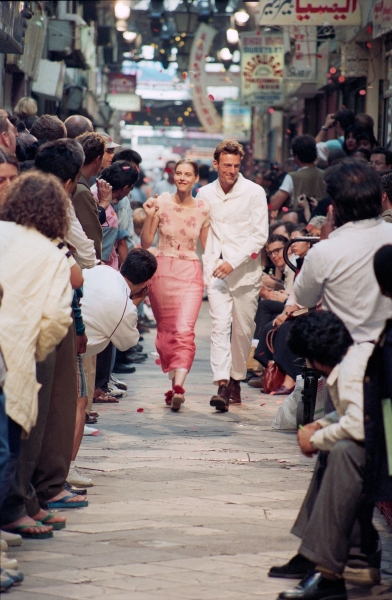
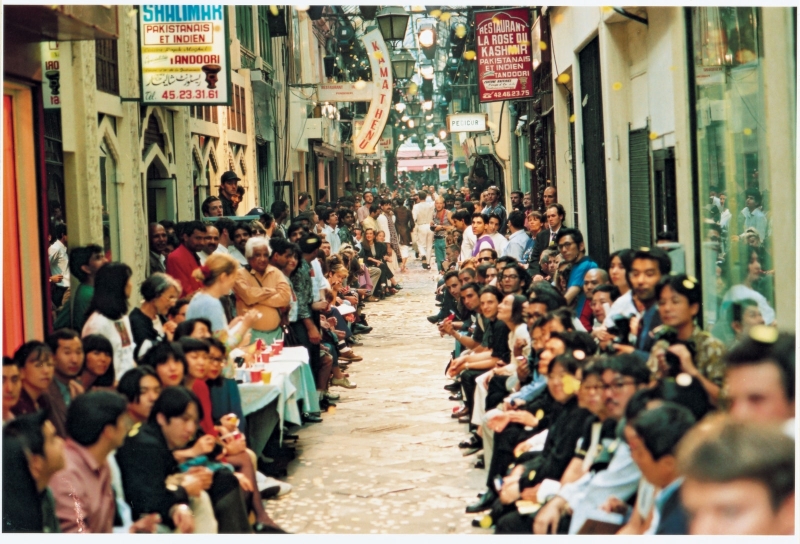
Spring 1994 Menswear
“This was on the 2nd of July 1993 at 4 pm. The music was Bollywood soundtracks. There was a time in Paris when Dries was my only customer so I would come here and do location scouting for three or four days and select maybe eight venues to show him. Nowadays if you have two venues to present it’s amazing. This was Passage Brady, a passage that is a mix of Indian, Pakistani, and some African businesses—a very big mix. Basically to give the businesses the ability to function during the show we printed some fake money, fake currency, and gave it to the guests to spend as they liked—they could buy drinks, or food, or a souvenir. And at the end of the show we paid the businesses for the money they had taken. Another thing is that because we could not close the passage the show was full of people who came in and participated. They were dancing and getting involved. It was a lot of fun. This was also the time where the models could be a lot more lively. They were interacting with the guests and the audience and there was joy. A certain joie de vivre that was also in the collection.”
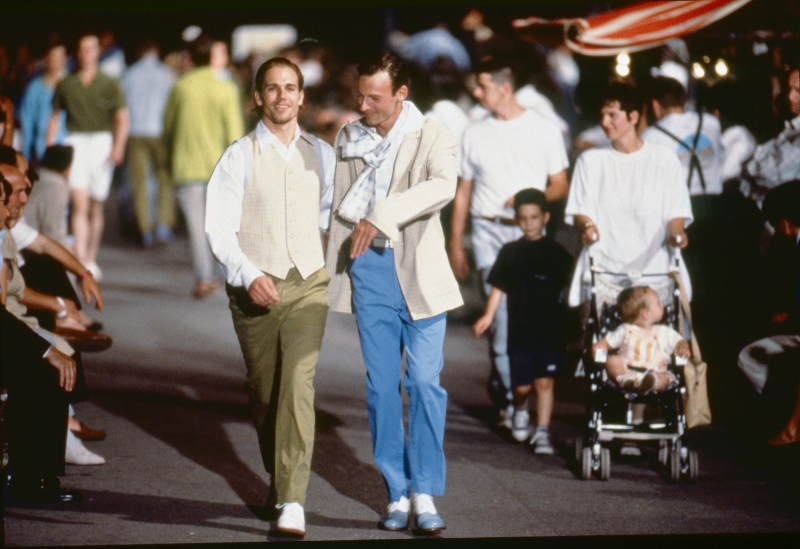
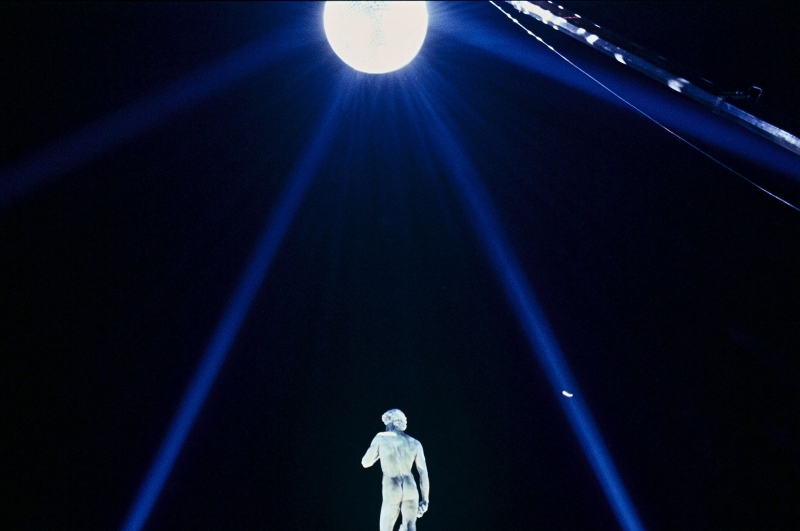
Spring 1996 Menswear
Dries was invited to be the guest at Pitti. The main show of the week. They started showing us the venues that they proposed and we said no to everything. Because we loved Piazzale Michelangelo. But Pitti and the authorities said we were crazy because there are thousands of people who come through this square every day. It’s impossible. But we said well it’s either there or we cannot do the show! We wouldn’t act this way normally, but there are moments when you have to.
In the run-up we went to the Piazzale in the morning, during the day, and at night. And we observed that in the morning it was tourist time, with the busloads of visitors from Japan and all the stores selling souvenirs. And then when those shops would close in the early evening you would get all the guys selling the fake bags. And then at night young guys would come as a group. They would park their cars and have a drink and turn on the music. So we wanted to recreate this in a show.
We really wanted it to look like a movie, which meant the lighting was extremely important. I wrote to Pasqualino de Santis who had won an Oscar for his work with Zeffirelli, and he said ‘ok, I’ll meet you.’ He came from Rome. He was amazing. He worked until the last minute: sometimes he would put four filters on one lamp just to get the effect he wanted. It was amazing to work with people like this. Afterwards actually he asked me to work with him but because I was working with Dries I said no. I regret this sometimes. But that night was incredible. We made pizza for 2,000 people and there was a party in the piazza, with the tourists and the guys selling the bags and the local guys hanging out. There was this disco ball that threw lights everywhere and afterwards we had fireworks. And if you look at that show today it does not look like a videotape, it looks like a movie.

Fall 1996 Menswear
We specialized in finding places that were not supposed to do fashion shows. Why? Well, when the Belgians came to Paris, with Margiela a couple of years before, people were showing at the Carrousel du Louvre—there was no culture of finding a place that would translate the collection into emotion. I would like to think we were amongst the first ones to bring out fashion show. So we thought out of the box and off the beaten track. With Dries he knew beforehand where he was going with his theme. This time it was Indian wtreetwear. We showed in the market at Barbes-Rochechouart. We gave people gluhwein and roasted chestnuts. We would always try to make it lively so people would have a slice of experience that would take them to the collection. And during the show it started snowing. It was beautiful.
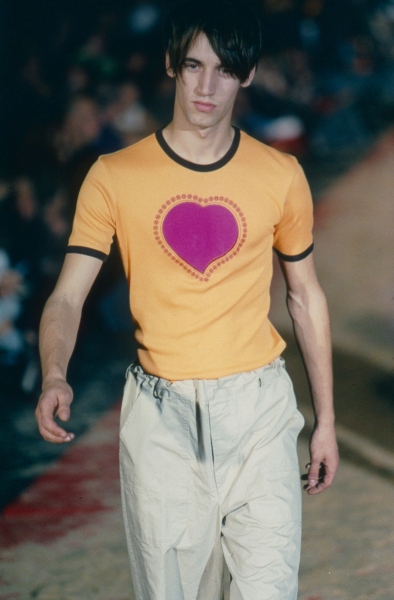
Spring 1997 Menswear
This is one year after Florence. Again in menswear. And there was this idea to make a Moroccan village of typical Caidal tents. So I went many times to commission tables, to buy lanterns and carpets and a lot of the things we wanted to build on this stretch of land almost in front of the Seine. The idea is the guys would go through the tents, while the guests were sitting down on big pillows, eating and drinking and enjoying the hospitality. We were very happy with how it looked. There are not as many pictures as I want from that village but I remember going to sleep the night before feeling very happy about how it was looking.
At 4:30 am I got a call from security on the site. There had been so much rain overnight—even though it was July and the tents had some protection—that the water was dripping through the seams. The water started to rise from the ground because there was so much rain and it filled the tents. So maybe at around 7:30 am I realized it was never going to work. The show was at 4:30. Across the road then was this exhibition space, Espace Eiffel-Branly. I ran across the road and asked to see the director. I remember saying: “It is a matter of life or death.” They called her and she said she would come in 45 minutes. I told her what we were facing. I said I need your help. Please, I need you to lend me the space. And she said yes!
Then Dries arrived. When Dries is nervous he does not look nervous at all. He looks extremely calm. He went to enter the venue and I said no, you do not want to see this. And I took him over the road. We had spent three days preparing the space and we had three hours to make the new space. At this point the Dries team, the selling team, all the team was arriving—and I have never seen anything like that. We were like ants, working together. When the photographers arrived they helped to build their pit. And when the guests arrived we sent them across the street and we managed to do it. It was so intense. This was the closest to the cliff’s edge. If the director had said no, there would have been no show. And it worked. People understood, and we had a standing ovation: and it was because everyone worked together.
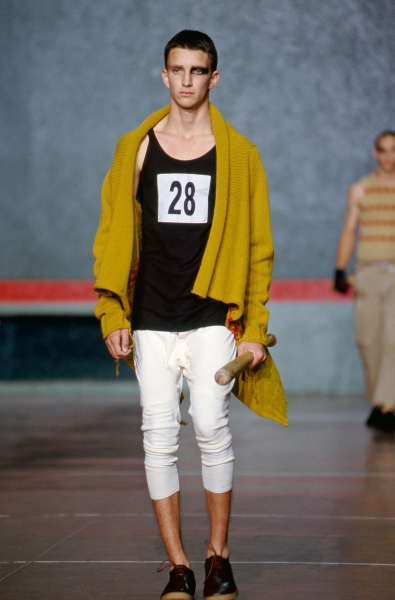
Spring 2000 Menswear
This was the Clockwork Orange theme collection. It was one of my favorites. I think this was when Dries started to introduce skirts over jeans or pants. The looks here were quite something, with the baseball bats and the darkened eyes—it was aggressive. It was at Fronton Trinquet, and the original plan was for it to be outside in this sports area. But because of the rain we had to move inside into the basement. And sometimes weird things happen. Because what we could never have invented is that this was an indoor sports complex for pelota and there was a glass dividing the runway area from where we had to put the audience. So during the show it was if the models were being kept away from you: it was very menacing. And then at the end of the show when we flipped the lights the audience could suddenly see themselves reflected in the glass, watching. It was very powerful.
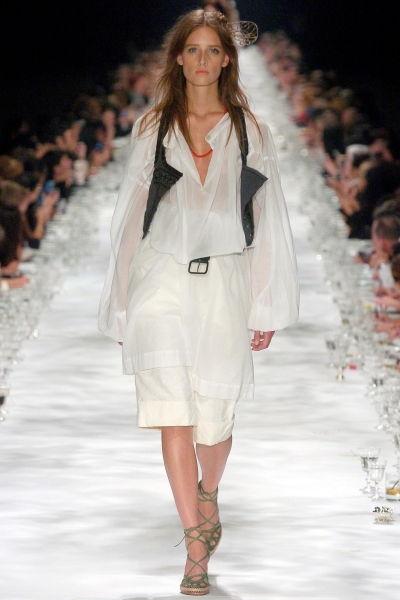
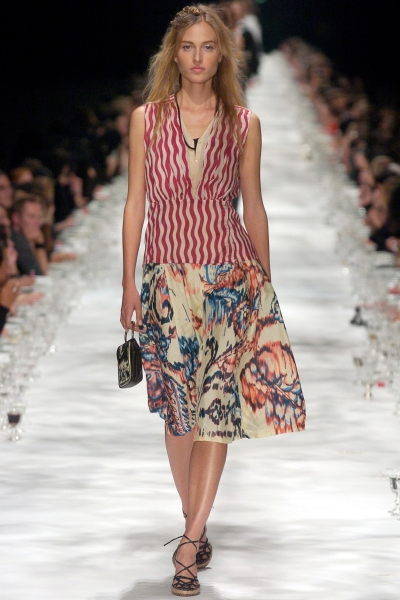
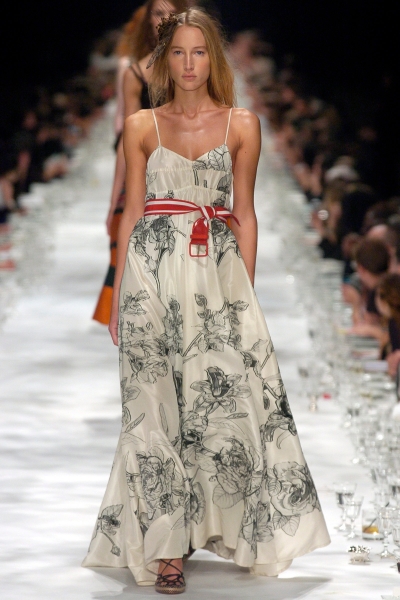
Spring 2005 Ready-to-Wear
Now we jump to the 50th show. It was on October 6, 2004, so basically it’s nearly 20 years ago. It was out in La Courneuve at the Babcock & Wilcox factory. And actually that is where we will be doing the last-ever show this Saturday.
What we wanted to do was have a dinner for 500 people with one table only and this is the only venue we could find that would fit. La Courneuve had a bit of a reputation but we were not from Paris and we were not aware, and the venue was beautiful. Very Dries. The idea was that the people would arrive, have an aperitivo, and then move to the 150-meter-long table. There was only one seam in the tablecloth— it was made of only two pieces of fabric—so we had to bring it in on a cart. And the dinner was under 150 chandeliers hung low over the table to create this super low light. So the people had dinner, not expecting for a second what was to happen. Actually another challenge was how do we serve 500 people at the same time? I wanted 500 waiters but it was too expensive so we had 250. Then we had to make sure every waiter knew who they had to serve—we ended up marking the number they had to serve. The other challenge was how to ask them to move at the same time to serve the dishes, so we decided to put small lights like traffic lights—red, orange, and green. We had this army of 125 people on either side of the table who moved at exactly the same time. The guests applauded that! Then the chandeliers were raised and the show started—the models came out on the table. The next challenge though was that the models had to change, so to get them back to the other side of the table and backstage in time we had to transport them on golf carts. The music was the Bolero and Dries had said his dream was for the last model to leave from in front of the photographers just as the last note played. And we did it. It was about timing. I think we were blessed by luck that day. Every time I finish a show I review it and there is always something I find that we could have improved. This show, even 20 years later, this show is the one where I would change nothing; nothing, nothing, nothing. Even if it doesn’t exist, we always aim for perfection, for everyone we work with. This was the closest we ever came to touching it, even if just for a microsecond. It was a magical moment.
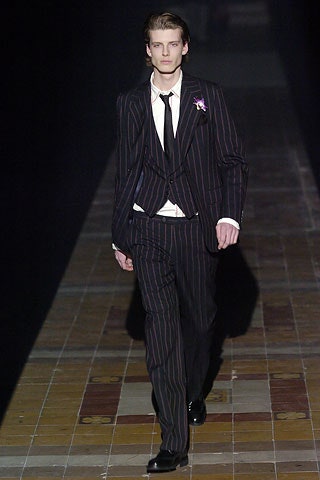
Fall 2005 Menswear
Dries was extremely satisfied with what we had achieved for the 50th show. But the question it left us with was, what’s next? I had maybe the best briefing I ever had, because Dries said: “I want simplicity, a simplicity that hurts.” It was about cleaning the palate. We held it at the École des Beaux-Arts. It was the first page of a new book. So we had one light only: instead of 150 chandeliers there was a single beam of light from a projector, casting the long flickering shadow down the runway. The models smoked so the smoke would billow around them. And the soundtrack was not music, it was a reading of a text by Paul Auster telling the story of the returned kiss. We put two voice artists in a studio and recorded it. And we played the sound super low and put the speakers right next to the guests. It was very intimate and close. I have super good memories of this show because of the balance against what came before it. It was so simple it hurt.
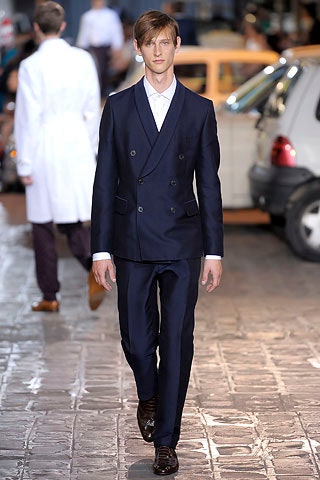
Spring 2009 Menswear
The location is called the Halles aux Chevaux. It was an old horse market transformed into a carpark. The music was Gary Newman’s “Cars.” And the decor was 200 white cars that we found in and around Paris. There were no Lamborghinis or anything like that—it was a Fiat Punto, or Panda, mixed with a nice Cabriolet and a fine Renault. It could have been a real carpark, just full of white cars. The whole show started all white. A few of the cars, by Simca, were lent by collectors so we had collectors from all over France who brought them. And the whole runway was defined by the way the cars were parked. And we used the trunks of the cars full of ice-boxes to serve drinks and snacks. It brought a beautiful atmosphere.
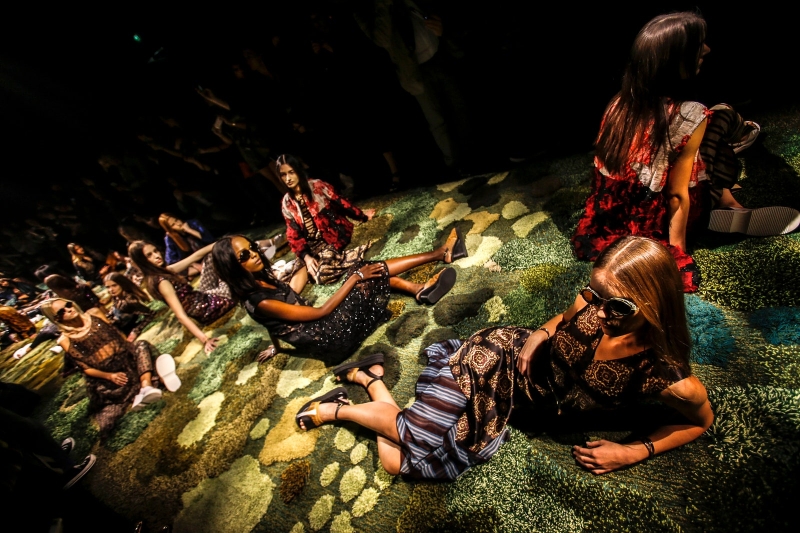
Spring 2015 Ready-to-Wear
This was actually close to 10 years ago, now, in September 2014 at the Grand Palais. We wanted real moss, but it did not really work. So, how to get around that? Well we found this artist who was based in Argentina named Alexandra Kehayoglou, who had this incredible practice making very special types of carpet. She only had three weeks to make it. I remember the morning of the show she was in the Grand Palais nipping her “moss” with a pair of nail scissors! It was so beautiful. The scenography was beautiful. When we saw the carpet we realized we had to do something special. So at the end the models came in and staged a sit-in instead of walking. They came in and took their place, they fell to their slumber.
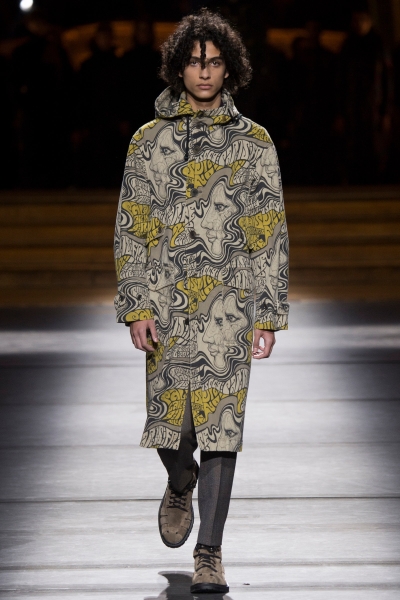
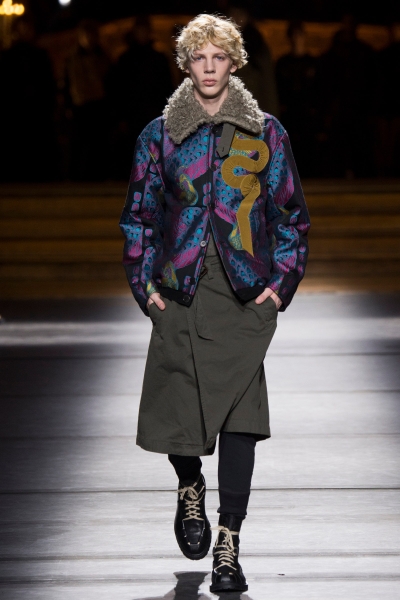
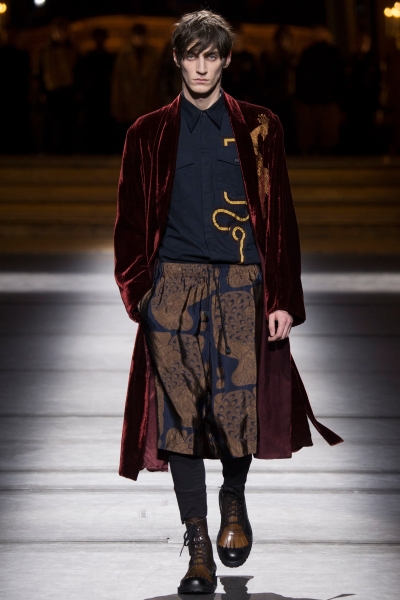
Fall 2016 Menswear
Basically what this show tells me as a producer is that persistence is powerful. It was a dream since day one to be able to do a show on the stage of the Paris Opéra at the Palais Garnier. Every season for 17 years, we’d been asking. It was always: “no. We have a rehearsal. We have a show.” We called every season, menswear and womenswear. Until finally they said we had 24 hours to come in, come out, and do the show.
A friend of Dries, Robert Carsen, had directed the production of Strauss’s Capriccio that was running at the time and they allowed us to keep a piece from the set on the stage. I remember it was beautiful; the audience went through the back of the building—what they call the elephant stairs—into the stage where they sat along the side. And the models came out from la cage de scène, which was this amazing 18-meter-high space. The grandiosity of that stage, and the technicity of the space. It was extremely special. Where there’s a will, there’s a way.
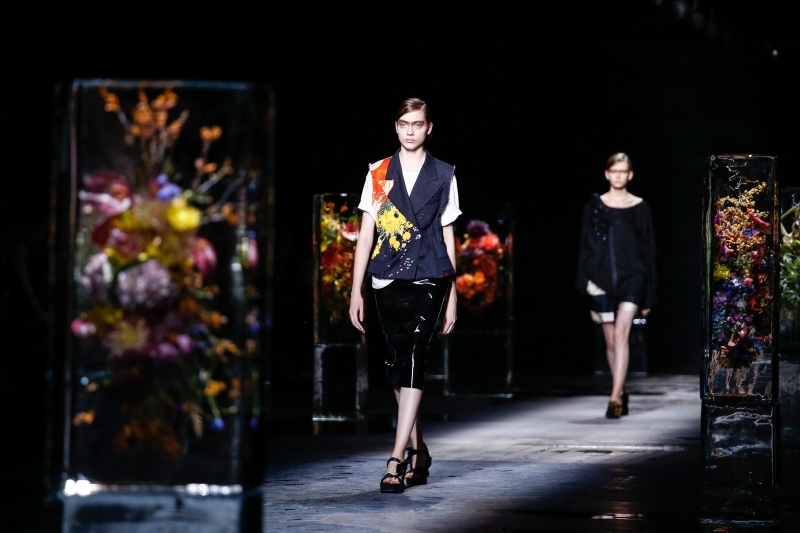
Spring 2017 Ready-to-Wear
We had the chance to work with Azuma Makoto, the artist florist, and he created these 23 bouquets which during the show sat in 1.5-meter blocks of ice. And who knew that you could freeze flowers without burning their petals? Azuma came to Belgium and made the bouquets but we had the responsibility of freezing them. We discovered that you can only freeze them without damage if you do it extremely slowly. If I remember correctly it took 22 days. And to have very clear ice is also the challenge. But the show was during one of those very hot Septembers. And when the blocks arrived the night before they were already starting to drip. On the runway there was another beautiful accident when the water that spread on the floor picked up the light and reflected the blooms. It was another special show.

